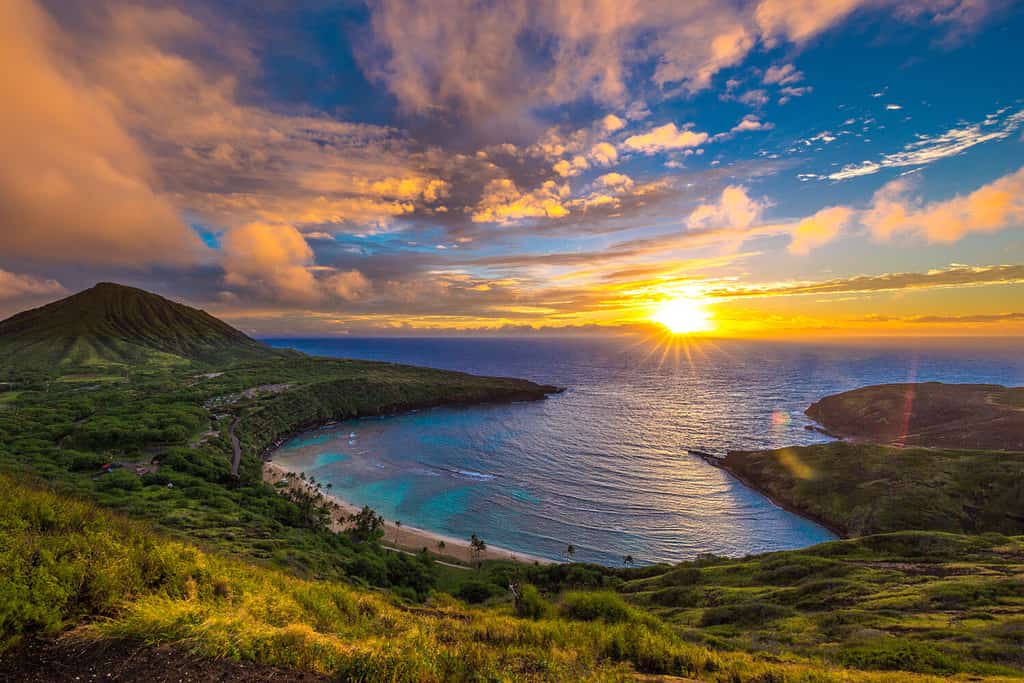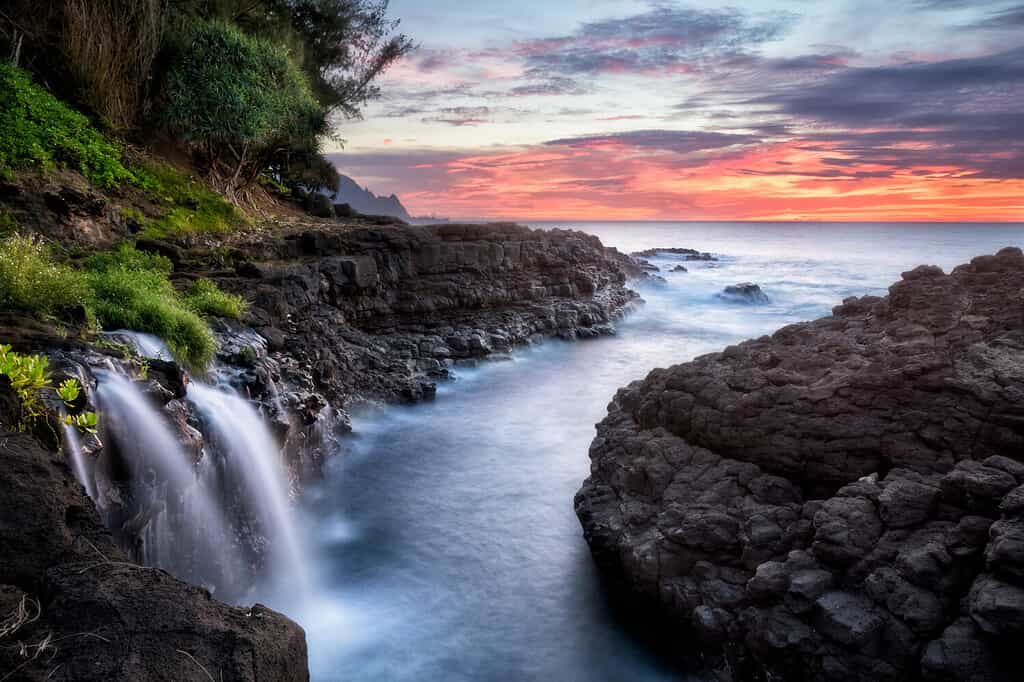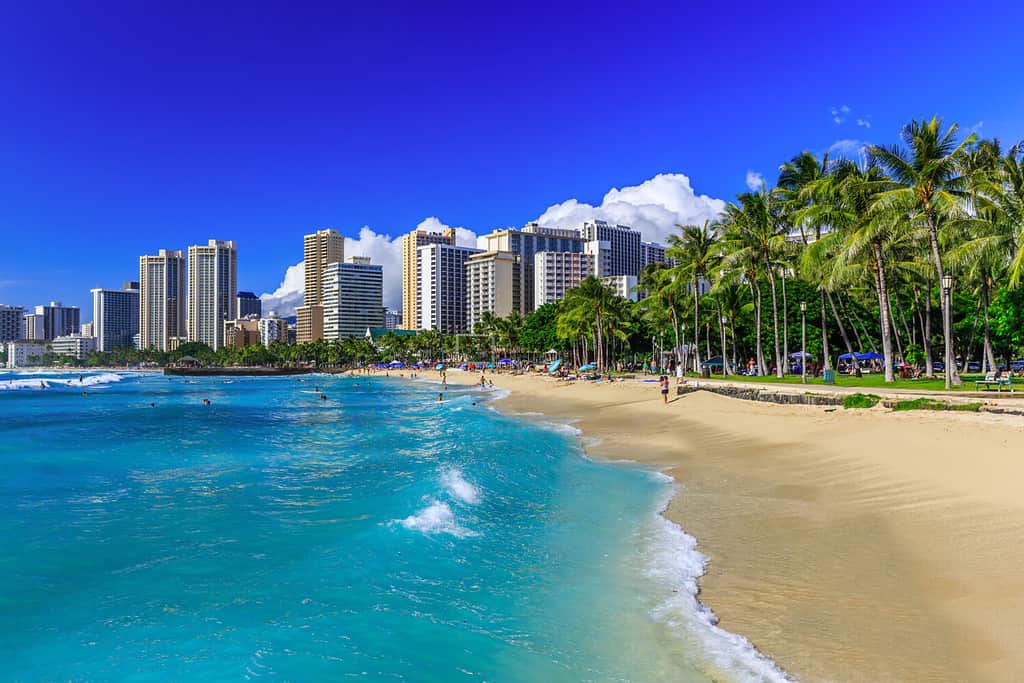While you can visit Hawaii any time of year and expect to have a delightful visit, certain seasons are better than others. Three major factors impact the best times to visit, including the weather, the off-peak season (i.e., tourism), and natural phenomena.
Before you plan your trip to the land of pineapples and sea turtles, you’ll want to consider these things affecting the Aloha State and its best seasons.
Hawaii’s Climate

The Heart of Kauai: Mount Waialeale and the Weeping Wall, Hawaii. The wettest place on Earth due to orographic precipitation. It’s also one of the most beautiful.
©EdoTealdi/iStock via Getty Images
Hawaii has two main seasons each year: summer and winter. Springtime and autumn are extremely limited here, thanks to the state having a tropical climate with warm temperatures year-round. At sea-level in summer, the average temperatures reach around 85 degrees Fahrenheit. Wintertime, the average temperature only drops down to 78 degrees Fahrenheit on average. The location within the islands, of course, can affect this somewhat, as does the rainfall and other factors affecting the climate in general. Occasionally, some may even call Hawaii “chilly” and put on a sweater.
Average Weather in Hawaii Each Month
Considered a mild tropical climate with moderate humidity, Hawaii is warm to hot year-round. The summer peaks around 86 degrees F, while the winter drops only a few degrees down to 78 degrees F. Summer runs from May to October, while winter runs from October to April.
Based on temperatures and weather overall, the best time to visit Hawaii is between March and May or September to November.
Hottest Summer on Record for Hawaii

Brilliant sunsets, pristine beaches, and incredible wildlife. You couldn’t ask for more! But when is the best time to visit Hawaii?
©Shane Myers Photography/Shutterstock.com
The hottest temperature ever recorded in Hawaii hit on April 27, 1931. At an elevation of 870 feet on Pahala, the temperature reached 100 degrees F. Pahala is on the Big Island, the northernmost town in Ka’u district. The town once housed a large sugar can plantation, which eventually closed in 1996 because of the low demand for the cane. The town normally is hotter than others around it during the summer months.
Overall, the hottest summer ever recorded was in 2019, with 2015 competing for the rank. 2019 saw more previous daily records broken than any other year past.
Coldest Winter on Record
The official coldest day on record for Hawaii was recorded on February 11, 2019. The temperature dropped to 8 degrees Fahrenheit during the same year that Hawaii saw its hottest recorded summer. This cold temperature was recorded atop the dormant volcano named Mauna Kea, at 13,796 feet. Hawaii remains the only state in the United States to never have seen a subzero temperature.
Prior to this date, the coldest recorded temperature in Hawaii was 12 degrees Fahrenheit, hit on May 17, 1979, at the Mauna Kea Observatory. This temperature was later deemed unreliable, however, due to the weather station used to record it as such was unreliable, as well.
Average Rainfall by Month

The stunning landscapes are just part of the appeal of Hawaii. But the rain is needed to keep those waterfalls flowing.
©Adam Springer/Shutterstock.com
October to March in Hawaii sees the most rain in the state. Average rainfall, however, is fairly low, with no average topping 3.25 inches.
- October average rainfall — 1.84 inches
- November average rainfall — 2.42 inches
- December average rainfall — 3.24 inches
- January average rainfall — 2.31 inches
- February average rainfall — 1.99 inches
- March average rainfall — 2.02 inches
Potential Natural Disasters to Consider Via Season
Three main issues may cause problems for your Hawaiian vacation. Hurricanes, tsunamis, and wildfires may break out on the islands.
Hurricane season in Hawaii runs between June 1 and November 30. Flooding, tsunamis, and other such issues may accompany these storms.
Tsunamis, on the other hand, do not have a specific season. They occur seemingly at random, depending on the events out in the ocean.
Wildfires also have no specific season in Hawaii, though they are more likely to happen in summertime during the dry season.
The Best Time to Visit Hawaii

Gorgeous, stunning Hawaii! You’ll find the fewest tourists here in May or between September and October.
©SCStock/Shutterstock.com
Because the weather is reasonably consistent throughout the year, that is warm to hot, many folks don’t think there’s a bad time to visit the Aloha State. However, a cross-section of factors can predict the best time for folks looking to avoid crowds and high prices.
Peak season in Hawaii falls between June and July and in December. Most consider these the worst months to visit the island chain.
Overall, travel experts and tourists alike suggest May as the best season to visit Hawaii. The temperatures haven’t reached their peak yet. Rainfall is rare and tourists aren’t flocking during the summer school breaks yet.
Other excellent times to visit Hawaii include:
- April (except holidays and spring break)
- September
- October
- January, particularly for those seeking whale watching opportunities
The photo featured at the top of this post is © Shane Myers Photography/Shutterstock.com
Thank you for reading! Have some feedback for us? Contact the AZ Animals editorial team.







